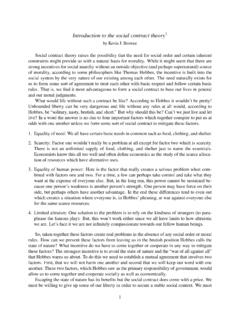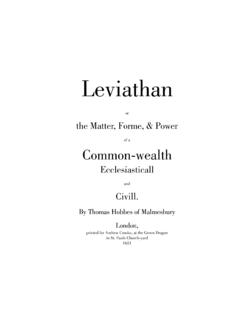Transcription of A Brief History of Public Relations - Larry Litwin
1 1 A Brief History of Public Relations Public Relations has been with us for thousands of years. The Greeks had a word for it: sematikos: to signify, to mean. Semantikos means semantics, which can be defined as how to get people to believe things and do things. That is not a bad definition of Public Relations . In 50 Julius Caesar wrote the first campaign biography, Caesar s Gallic Wars. He publicized his military exploits to convince the Roman people that he would make the best head of state. Candidates for political office continue to publicize themselves with campaign biographies and accounts of military exploits to this day.
2 In 394 , St. Augustine was a professor of rhetoric in Milan, the capitol of the Western Roman Empire. He delivered the regular eulogies to the emperor and was the closest thing to a minister of propaganda for the imperial court. Thus, St. Augustine was one of the first people in charge of Public Relations . The modern equivalent would be the President s press secretary or communication director. In 1776, Thomas Paine wrote The Crisis, a pamphlet which convinced the soldiers of Washington s army to stay and fight at a time when so many were prepared to desert so they could escape the cold and the hardships of a winter campaign.
3 Paine was a master of political propaganda whose writing could get people to do things and believe things. Benjamin Franklin made it a rule to forbear all contradiction to others, and all positive assertions of his own. He would say, "I conceive or "'I apprehend" or "I imagine a thing to be so, or it appears to be so. Franklin pioneered the rules for "personal Relations " in an era before mass media had made possible a profession called " Public Relations ." 2 In the middle of the 19th century appeared a man who was to become one of the leading publicists of all time, P.
4 T. Barnum. His accomplishments include the founding of the American Museum and the establishment of the Barnum and Bailey Circus. Barnum was a master of promotion who could fill his enterprises with customers by using what we today would call sleazy methods of publicity. For example, he announced that his museum would exhibit a 161-year-old woman who had been Washington's nurse. He produced an elderly woman and a forged birth certificate to make his case. William Seward, Lincoln's secretary of state in 1861, gained a large American audience through his understanding of how to use the press.
5 He told his friend jefferson Davis (they were friends before the war): "I speak to the newspapers they have a large audience and can repeat a thousand times what I want to impress on the Public . Public Relations became a profession in 1903 as Ivy Lee undertook to advise John D. Rockefeller on how to conduct his Public Relations . Rockefeller owned coal mines and the Pennsylvania Railroad. Miners were on strike and the railroad hushed up the facts when its trains were involved with accidents. Lee advised Rockefeller to visit the coal mines and talk to the miners.
6 Rockefeller spent time listening to the complaints of the miners, improved their conditions, danced with their wives, and became a hero to the miners. After a railroad accident, Lee invited reporters to inspect the wreck and get the facts. The Pennsylvania Railroad then obtained its first favorable press coverage. Lee professionalized Public Relations by following these principles: 1. Tell the truth 2. Provide accurate facts 3. The Public Relations director must have access to top management and must be able to influence decisions 3 Lee defined Public Relations , saying: Public Relations means the actual relationship of the company to the people and that relationship involves more than talk.
7 The company must act by performing good deeds. ON THE IMPORTANCE OF TRUTH: 1. Warren Buffet of Salomon Brothers: "If you lose money for the company, I will be understanding. If you lose one shred of the company s reputation, I will be ruthless. 2. Speaker of the House Sam Rayburn commenting on the integrity of Army Chief-of-Staff George Marshall: When General Marshall comes to talk to us, we forget whether we are Democrats or Republicans. We just remember that we are in the presence of a man who is telling the truth."" Public Relations took the next step toward professionalism in 1918 as Edward Bernays advised the President of the new country of Czechoslovakia to announce independence on a Monday, rather than on a Sunday to get maximum press coverage.
8 In 1923, Bernays published Crystallizing Public Opinion, in which he established several Public Relations principles. He said that Public Relations had these functions: To interpret the client to the Public , which means promoting the client To interpret the Public to the client, which means operating the company in such a way as to gain the approval of the Public Bernays and Lee were stressing the idea that the corporation should accept social responsibility. Bernays ideas about social responsibility led to his refusal to accept unethical clients.
9 4 He created the concept that there are many publics and each Public needs to be appealed to. He advised Public Relations professionals to seek out group leaders and other key communicators (opinion leaders), who would be able to pass along ideas to other members of the Public . Other Bernays concepts include: a. Public Relations is a Public service b. Public Relations should promote new ideas and progress c. Public Relations should build a Public conscience Bernays put his ideas into practice when he took on as clients Proctor and Gamble and the Columbian Rope Company.
10 Proctor and Gamble had produced a radio commercial, which was offensive to African-Americans. Bernays took these steps: a. He changed the commercial b. He got the company to offer African-Americans significant jobs c. He invited them to tour the plant d. He featured African-Americans in the company newsletter The Columbian Rope Company had an anti-union image. Bernays took these steps: a. He produced a radio program featuring union and management panelists b. He induced the company to bargain with the union c. He offered tours of the plant d.







